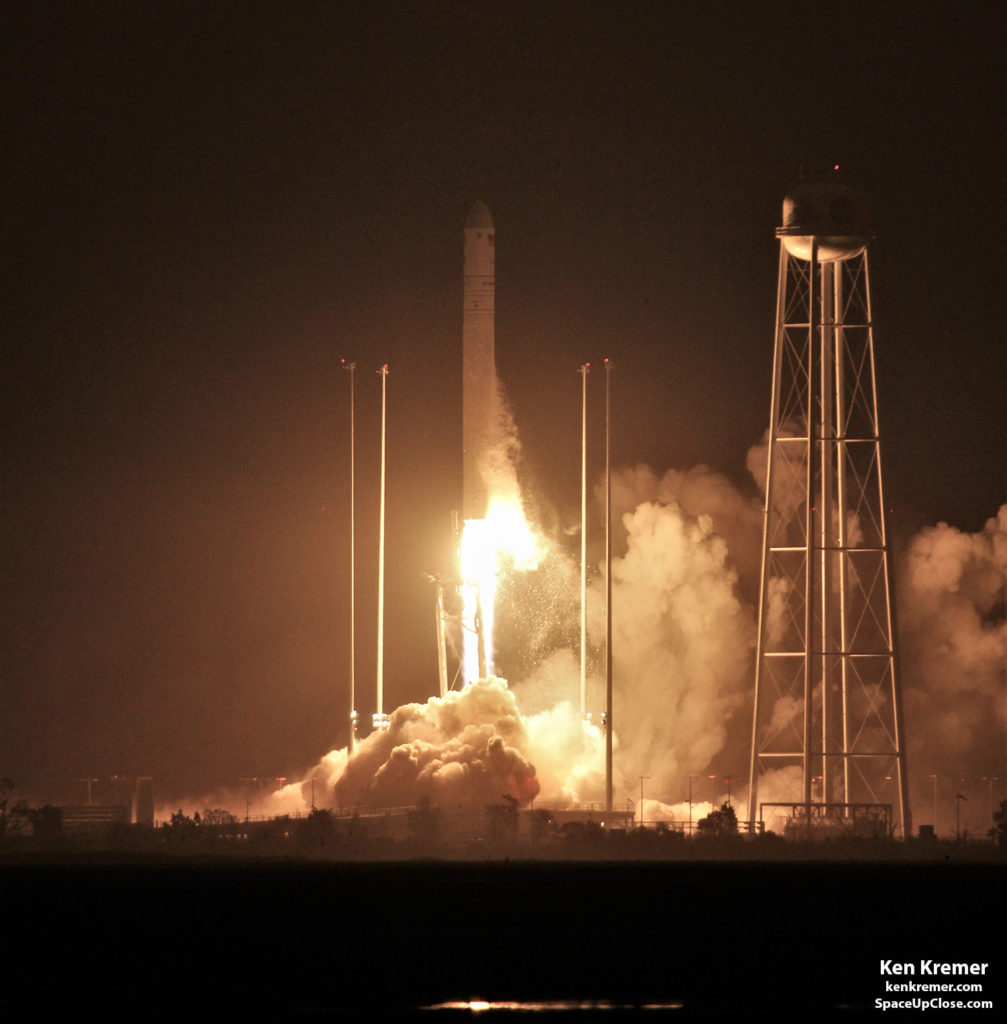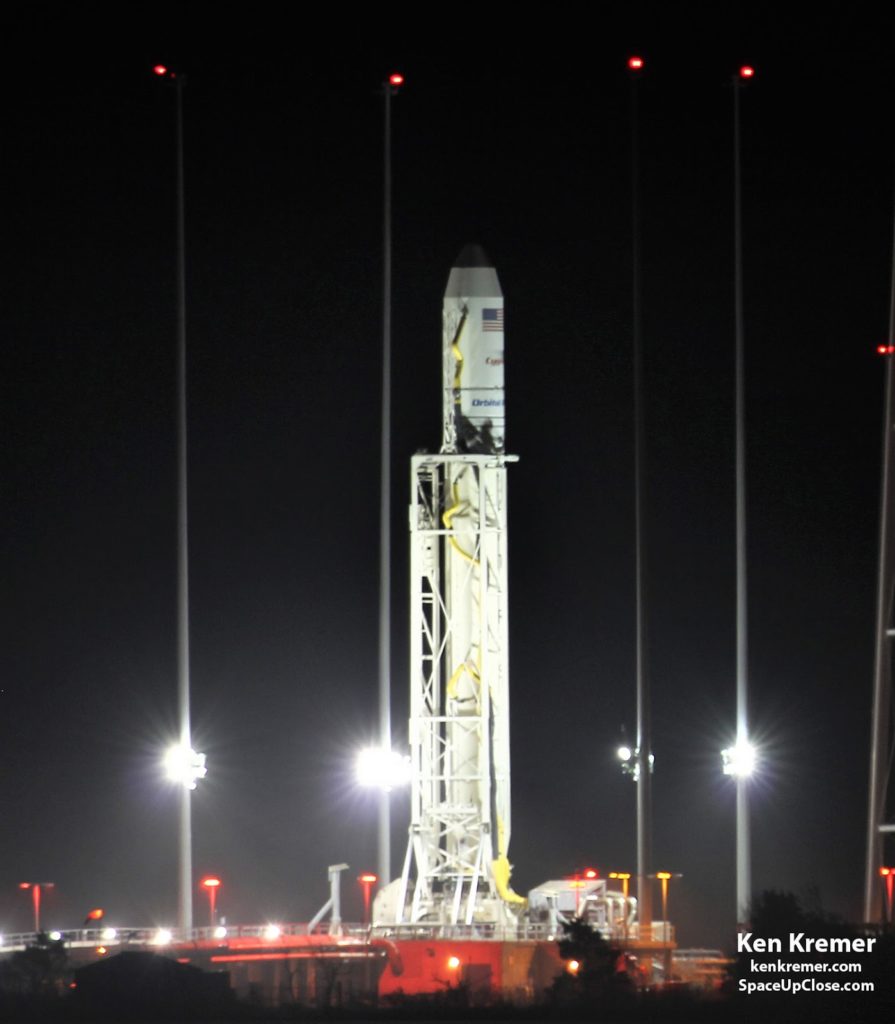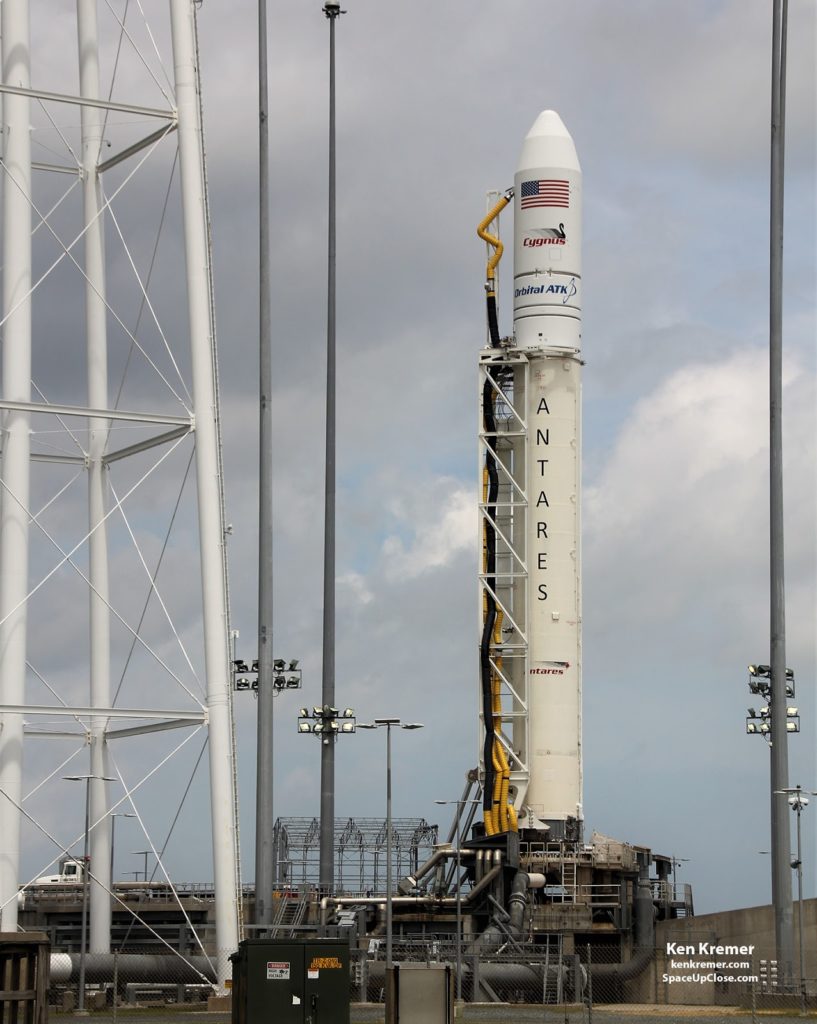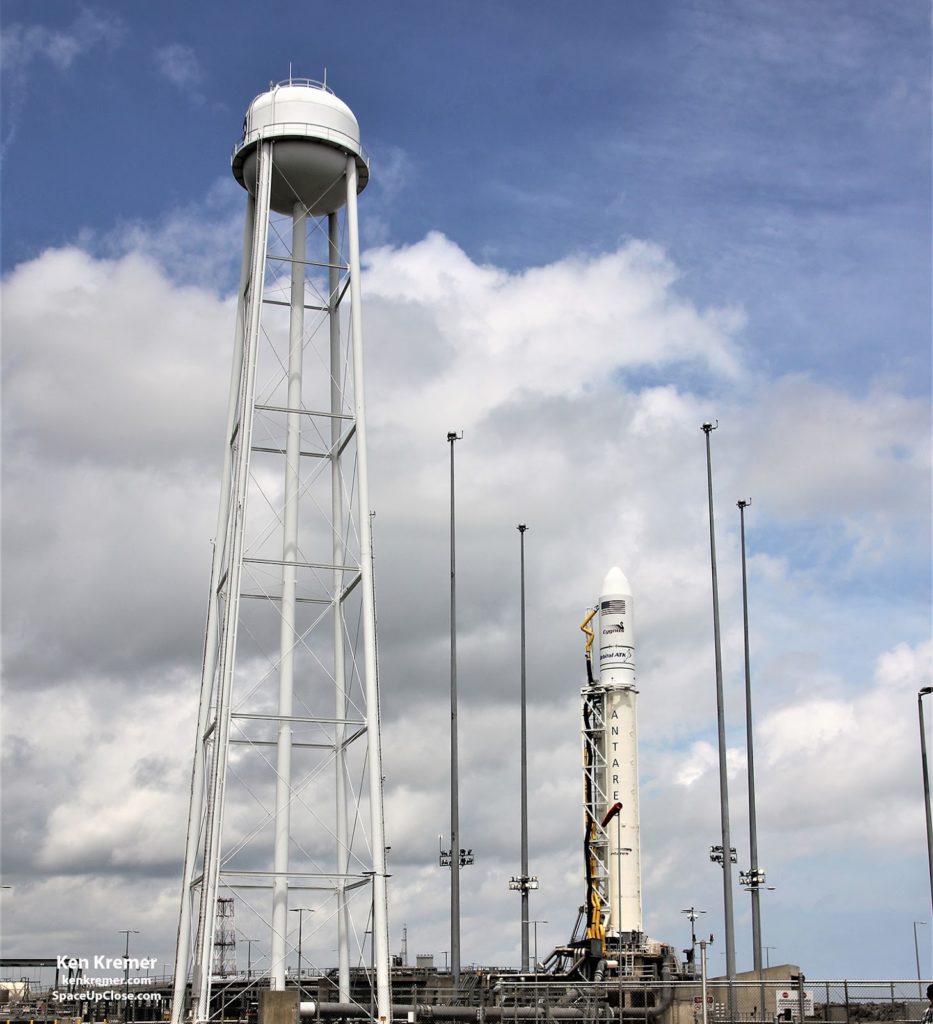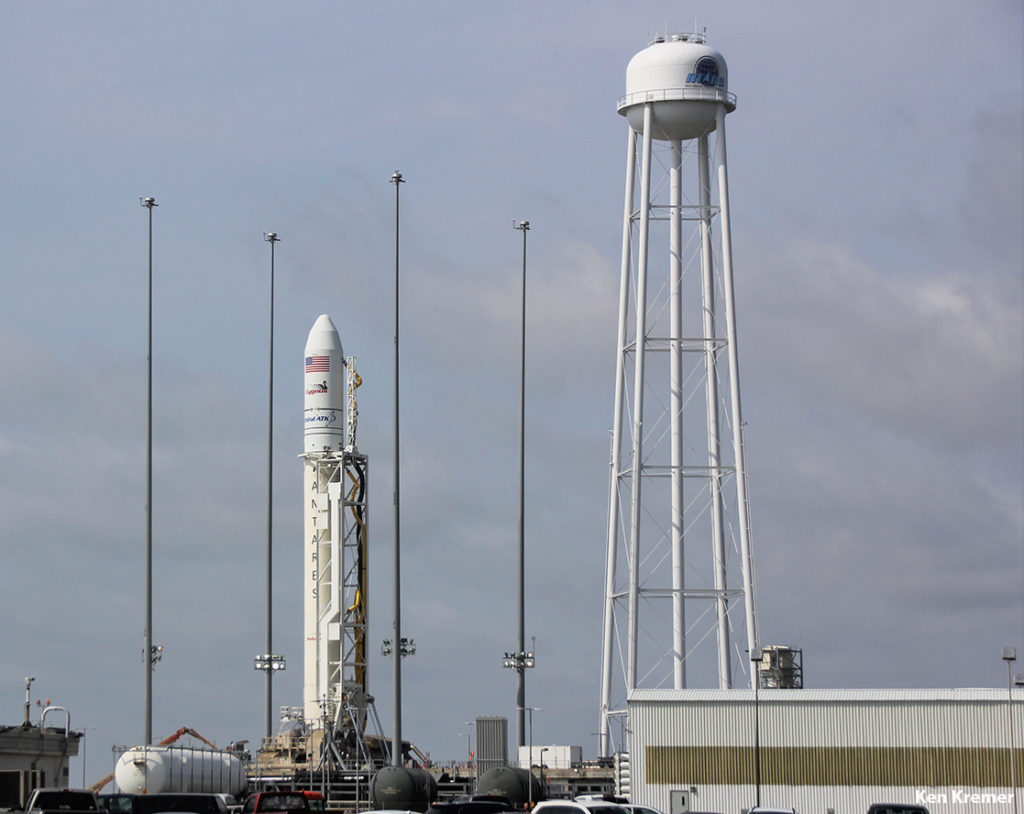ATK Antares rocket blasted off and streaked to orbit successfully at 4:44 a.
EDT with over 3 tons of NASA science and research investigations and gear on a Cygnus
cargo resupply mission bound for the International Space Station (ISS) after a
stunning nighttime launch from NASA’s Wallops Flight Facility on Virginia’s
Eastern shore on May 21.
Cygnus lifted off on an upgraded two stage Antares
230 rocket from NASA’s Wallops Flight Facility in Virginia on Orbital ATK’s
ninth contracted cargo mission under NASA’s Commercial Resupply Services
contract took place under overcast skies with distant thunderstorms threatening
the launch until almost the last moment.
also caused the team to psuh the launch to the very end of the 5 minute launch
window.
it all went well and cheers erupted from the crowd as the RD-181 engines
ignited and Antares ever so slowly liftoff off.
cloud deck but was visible for over six minutes. Even the
2nd stage firiong coud be seen in the dim ground haze as the rocker
arced over and accelerated to orbit.
 |
|
The Orbital ATK Antares
rocket blasts off with Cygnus OA-9 spacecraft from Pad 0A Monday, May 21, 2018 at NASA’s Wallops Flight Facility in Virginia on 9th contracted resupply mission for NASA to the International Space Station to deliver 3.7 tons of research and food and gear – in this remote camera view from the pad. Credit: Ken Kremer/kenkremer.com/SpaceUpClose.com |
delighted spectators and local residents alike.
loud and woke those who forgot to rise in time with a loud rumbling. Quite a
few folks told me they were shocked out of bed by the loud noises that shook their
houses and rattled windows to the
foundations too!
Cygnus vessel is jam packed with over 3.5 tons (7400 pounds) of science, research equipment, cargo, food,
water, spare parts and supplies bound for the six person multinational crew
living and working aboard the million pound orbiting outpost
support more than 50 of the more than 250 investigations underway on the space
station for the Expedition 55 and 56 crews..
measures 42.4 meters in height and 3.9 meters in diameter. The Cygnus has a pressurized volume of 27
cubic meters and is 6.39 m in height. It is loaded with 800 kg (1764 lb) of
propellants.
alternatively named CRS-9 or OA-9, is Orbital ATK’s ninth contracted cargo
delivery flight to the International Space Station for NASA.
vital equipment, supplies and scientific equipment to the space station as part
of Orbital ATK’s Commercial Resupply Services (CRS) contract with NASA.
will use the space station’s robotic arm to capture Cygnus when it arrives at
the station Thursday, May 24. Live coverage of the rendezvous and capture will
air on NASA Television and the agency’s website beginning at 3:45 a.m.
Installation coverage is set to begin at 7:30 a.m.
 |
|
The Orbital ATK Antares
rocket blasts off with Cygnus OA-9 spacecraft from Pad 0A Monday, May 21, 2018 at NASA’s Wallops Flight Facility in Virginia on 9th contracted resupply mission for NASA to the International Space Station to deliver 3.7 tons of research and food and gear – in his remote camera view from the pad. Credit: Ken Kremer/kenkremer.com/SpaceUpClose.com |
Cygnus is a centuries-old method of celestial navigation. The Sextant Navigation investigation
will explore the use of a hand-held sextant for emergency navigation on
missions in deep space as humans look to travel farther from Earth. The ability
to sight angles between the Moon or planets and stars offers crews another option
to find their way home if communications and main computers are compromised.
environment of the space station, and understanding long-term effects of space
travel on both, are critical to NASA’s plans for long-duration, deep space
exploration. The Biomolecule Extraction and Sequencing Technology (BEST)
study is the agency’s next step toward advancing in-space DNA sequencing
technologies that can identify microbial organisms living on the space station
and understanding how the DNA of humans, plants and microbes are affected by
microgravity. BEST will use a process that sequences DNA directly from a
sample, with minimal preparation, rather than using the traditional technique
of growing a culture from the sample.
 |
|
The Orbital ATK Antares
rocket blasts off with Cygnus OA-9 spacecraft from Pad 0A Monday, May 21, 2018 at NASA’s Wallops Flight Facility in Virginia on 9th contracted resupply mission for NASA to the International Space Station to deliver 3.7 tons of research and food and gear – in his remote camera view from the pad. Credit: Ken Kremer/kenkremer.com/SpaceUpClose.com |
In the realm of modern physics, the new Cold
Atom Lab (CAL)
on Cygnus could help answer some big questions. CAL creates a temperature 10
billion times colder than the vacuum of space, then uses lasers and magnetic
forces to slow down atoms until they are almost motionless. In the microgravity
environment of the space station, CAL can observe these ultra-cold atoms for
much longer than possible on Earth. Results of this research could lead to a number
of improved technologies, including sensors, quantum computers and atomic
clocks used in spacecraft navigation.
July with several tons of trash and burn up during re-entry into Earth’s
atmosphere, over the Pacific Ocean. The vehicle is named after James “J.R.”
Thompson, a leader in the aerospace industry.
worked continuously aboard the International Space Station, advancing
scientific knowledge and demonstrating new technologies, making research
breakthroughs not possible on Earth that will enable long-duration human and
robotic exploration into deep space. A global endeavor, more than 200 people
from 18 countries have visited the unique microgravity laboratory that has
hosted more than 2,400 research investigations from researchers in 103
countries.
SpaceX, ULA, Boeing, Lockheed Martin and more space and mission reports direct from the Wallops
Flight Facility, Kennedy Space Center and Cape Canaveral Air Force Station,
Florida.
Earth and Planetary science and human spaceflight news: www.kenkremer.com –www.spaceupclose.com –
twitter @ken_kremer – ken
at kenkremer.com



